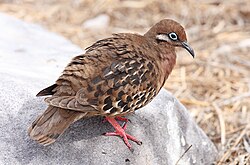Galapagos dove
| Galápagos dove | |
|---|---|
 |
|
| Española, Galápagos | |
| Scientific classification | |
| Kingdom: | Animalia |
| Phylum: | Chordata |
| Class: | Aves |
| Order: | Columbiformes |
| Family: | Columbidae |
| Genus: | Zenaida |
| Species: | Z. galapagoensis |
| Binomial name | |
|
Zenaida galapagoensis Gould, 1839 |
|
The Galápagos dove (Zenaida galapagoensis) is a species of bird in the family Columbidae. It is endemic to the Galápagos, off Ecuador. It is fairly common and is found in a wide range of open and semi-open habitats, especially in the arid lowlands of the archipelago.
The Galápagos Dove grows to measure between 18 and 23 centimeters long. An attractive bird, the Galápagos dove has dark reddish-brown upperparts, a pinkish neck and breast, a buffy-coloured belly, and brown wings, streaked with white and black. The long downward curved beaks on the Galápagos Dove helps it feed mostly on seeds and fruits from the ground. Very reluctant to fly in the air, it will only do so as a last resort. Galápagos Doves spend most of their time on the ground or lowlands searching for food, mainly feeding off the Opuntia Cactus and caterpillars. They inhabit rocky lowlands, scattered trees, bushes, and cacti. Due to the scarce number of bees, these doves form similar functions to that of a bee. The softening of the Opuntia Cactus allows these doves to pollinate. In the mid to late 1600s, Galápagos Doves were mainly hunted by sailors, but are now hunted by the feral cats that are present on the Galápagos Islands. Other threats to the Galápagos Doves are diseases, pollution, and habitat degradation. Whenever their nests are in danger, the doves will pretend to be hurt or injured and lure the invader away from its nest. Most Galápagos nest are built on the ground, or no more than 30 inches high. The average nest can carry up to two eggs. Results show that seasons and weather have an impact on the breeding habits of Galápagos Doves. Studies show the wet season for the Galápagos Islands being in early January.
Galápagos Doves are a example of how a species adapts to its very own habitat or territory when mankind interacts with the species and its environment. The 1685 Galapagos Island expedition by the British Privateers is where the first interaction of Galápagos Doves and humans took place. The Galápagos main or primary characteristic is its extreme tameness. When British sailors first arrived to the islands, these Doves showed no fear toward the British sailors, coming in flocks, which made easy hunting targets for these British sailors. The flock of Galápagos Doves would approach, and sit on the heads and shoulders of these sailors, eventually leading to the hunting of these particular birds. The flock of doves proved to be an easy hunting tool for the British sailors, but the birds slowly began to dissipate. The birds eventually adapted to the human change by learning to avoid human interaction because of the threat of being killed for food and resources. Due in time, these doves became more frightful of humans. This is an example that Galápagos Doves developed a form of phenotypic recognition of humans. The phrase phenotypic plasticity is used when explaining doves and human interactions. This is the ability of an organism to change its phenotype in response to changes in the environment.Phenotype In this case, the Doves daily lives were altered when the British Privateers discovered the Galápagos Islands. This particular model of “animal resistance” to the onset of human existence proves that adaptation took place on the Galápagos Islands. These doves acquired the knowledge to avoid danger and altered their behavioral methods towards humans.
...
Wikipedia

